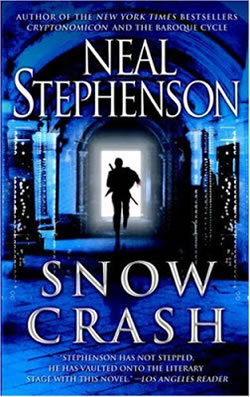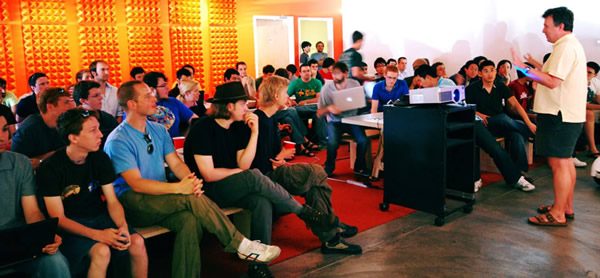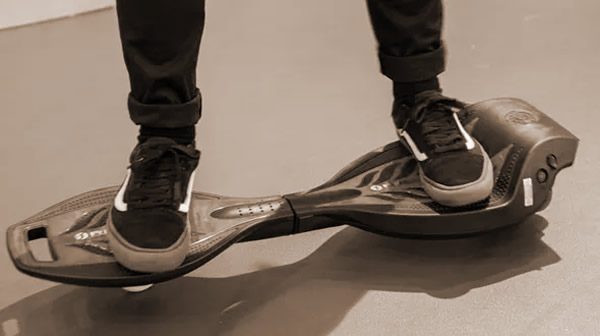Uncanny Valley
The RipStik gets a mention in Anna Wiener’s Uncanny Valley.
If you’re looking for some smart Sunday reading about the oft-neglected people aspect of technology, start with Anna Wiener’s Uncanny Valley, where she writes about her experience working that alternate reality known as San Francisco, circa 2013.
It’s a world where your culture and the company culture are one and the same, job descriptions are an energy-drink admixture of “HR’s idea of fun and a 23-year-old’s idea of work-life balance”, you can’t tell whether getting together over drinks is dating or networking, and FOMO hangs in the air like the city’s famous summer fog.

Here’s an excerpt:
A MEETING IS DROPPED MYSTERIOUSLY onto our calendars, and at the designated time we shuffle warily into a conference room. The last time this happened, we were given forms that asked us to rate various values on a scale of 1 to 5: our desire to lead a team; the importance of work-life balance. I gave both things a 4 and was told I didn’t want it enough.
The conference room has a million-dollar view of downtown San Francisco, but we keep the shades down. Across the street, a bucket drummer bangs out an irregular heartbeat. We sit in a row, backs to the window, laptops open. I look around the room and feel a wave of affection for these men, this small group of misfits who are the only people who understand this new backbone to my life. On the other side of the table, our manager paces back and forth, but he’s smiling. He asks us to write down the names of the five smartest people we know, and we dutifully oblige. I look at the list and think about how much I miss my friends back home, how bad I’ve been at returning phone calls and emails, how bloated I’ve become with start-up self-importance, how I’ve stopped making time for what I once held dear. I can feel blood rush to my cheeks.
“OK,” my manager says. “Now tell me: why don’t they work here?”

Another excerpt reminds me of the line from Neal Stephenson’s Snow Crash that’s stayed with me since first reading it in 1992: “It was, of course, nothing more than sexism, the especially virulent type espoused by male techies who sincerely believe that they are too smart to be sexists”:
WE HIRE AN ENGINEER fresh out of a top undergraduate program. She walks confidently into the office, springy and enthusiastic. We’ve all been looking forward to having a woman on our engineering team. It’s a big moment for us. Her onboarding buddy brings her around to make introductions, and as they approach our corner, my coworker leans over and cups his hand around my ear: as though we are colluding, as though we are 5 years old. “I feel sorry,” he says, his breath moist against my neck. “Everyone’s going to hit on her.”
I include this anecdote in an email to my mom. The annual-review cycle is nigh, and I’m on the fence about whether or not to bring up the running list of casual hostilities toward women that add unsolicited spice to the workplace. I tell her about the colleague with the smart-watch app that’s just an animated GIF of a woman’s breasts bouncing in perpetuity; I tell her about the comments I’ve fielded about my weight, my lips, my clothing, my sex life; I tell her that the first woman engineer is also the only engineer without SSH access to the servers. I tell her that compared with other women I’ve met here, I have it good, but the bar is low. It’s tricky: I like these coworkers — and I dish it back — but in the parlance of our industry, this behavior is scalable. I don’t have any horror stories yet; I’d prefer things stay this way. I expect my mother to respond with words of support and encouragement. I expect her to say, “Yes! You are the change this industry needs.” She emails me back almost immediately. “Don’t put complaints about sexism in writing,” she writes. “Unless, of course, you have a lawyer at the ready.”

Go and read Uncanny Valley. If my endorsement isn’t enough, take Paul “ftrain” Ford’s…
This essay is a great catalog of Silicon Valley self-deceptions by @annawiener. It builds soooooo calmly. https://t.co/QDTS17qdDT
— Paul Ford (@ftrain) April 25, 2016
…or Leigh Alexander, from whom I found out about the article in the first place:
this is such an excellent article: https://t.co/CMXOtqNr4V
— Leigh Alexander (@leighalexander) April 28, 2016
Inside Silicon Valley’s Big Pitch Day

Inside Silicon Valley’s Big Pitch Day is another piece by Anna Wiener about Y Combinator’s Demo Day, the show-and-tell held at the end of every March and August where companies funded by the seed accelerator firm parade their people and products to a room of very exclusive guests. She covers it not with the breathless tech-for-tech’s sake style that a more nerd-focused writer might employ, nor with the tech-for-getting-filthy-rich’s sake manner that someone with a Forbes-y/Business Insider-y bent would use. As she puts it:
I’ve worked in tech for a few years and love technology, if not always the techindustry: I’m neither an entrepreneur nor an engineer, I’m just a humanist with a sociology degree. I went to Demo Day as both an insider and an outsider, hoping to see a slice of the future.
She points out the sili-ness that comes with Silicon Valley, but at the end, she also points out reasons to be hopeful:
Still, to see one of Silicon Valley’s most lauded accelerators give a platform to people working in sanitation, social services, and healthcare felt tremendous. The future of technology is not necessarily in consumer or B2B software, and it’s not necessarily in the United States, either—some of the more compelling ideas came from international companies catering to local markets. These were hardly the most glamorous companies, but they were the companies that seemed most important to get in front of an audience with as much economic, cultural, and political clout as those assembled at Demo Day.
The Y Combinator motto is straightforward: “Make something people want.” At Demo Day, there were signs that the accelerator, and Silicon Valley as a whole, could also help companies make something people need.
For those of you who were curious about the company she was writing about in Uncanny Valley, she drops a hint in Inside Silicon Valley’s Big Pitch Day: “Full disclosure: From 2013-2014, I worked for a Y Combinator startup. The CEO was 24.”
Hacking Technology’s Boy’s Club

There are a precious few books that I have to keep buying over and over again because I keep giving away my copy to friends. One of these books is Close to the Machine: Technophilia and its Discontents by Ellen Ullman. Published in 1997, it’s a memoir that tells a good number of interesting stories, shows the human side of computer (and yes, there is one), and finally, it manages to pull off what should be impossible — it makes coding look interesting, and even exciting, to non-coders. As a reader of this blog, it may seem strange to you to not think of programming as exciting, but we’re the kind of people who look forward to a long flight as a chance to try out a new programming language or API.
Anna Wiener’s January 2016 article for The New Republic, Hacking Technology’s Boy’s Club, is a good intro to Ellen Ullman for those of you who aren’t familiar with her or her work. In some parts, we see an Ullman who’s concerned about the social issues of the tech industry and its products:
“It will not work to keep asking men to change,” Ullman told me. “Many have no real objective to do so. There’s no reward for them. Why should they change? They’re doing well inside the halls of coding.” To be perfectly clear: Ullman isn’t anti-geek-culture; she’s not anti-technology; she’s not anti-men. She doesn’t want to raze the clubhouse. She simply wants those inside to open the door.
…
Though she retired from the tech industry at the end of the last boom, to read Ullman’s work is to remember she’s been with us all along. Code, for all its elegance and power, is just a tool. “As with all advances in technology, the new offerings are often helpful, and marvelous—sometimes frightening, as with advances in surveillance,” she said. “The services are enormously convenient, but then there is the culture left behind. When we receive the dry cleaning delivery, we no longer see who does the work. We don’t see the tailor in the window, the presser surrounded by steam. When you order food on your phone from GrubHub, you don’t see the cooks and helpers in the hot kitchen.” The question of who delivers to whom, she continued, is directly related to inequality at large—it’s essential that the technologies we create and use are also building a world we want to live in.
But she’s just as into the hardcore, technical nitty-gritty that you and I love:
One afternoon last summer, I invited Ullman to my workplace. Within minutes, she and two young engineers were debating the merits of strongly typed languages, a conversation they’ve had many times before; it quickly became clear that Ullman had tipped the scales. “See? I told you so,” one said, vindicated. As enjoyable as it was to watch her, I was in over my head. Ullman noticed immediately. “Sorry—you must be bored,” she said. “This is fun for me.”

There you have it: three interesting articles by Anna Wiener. I look forward to reading more of her work.
